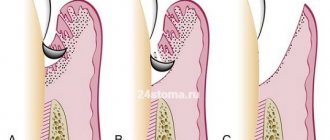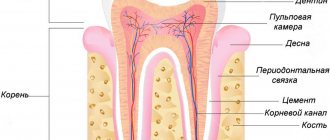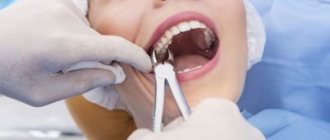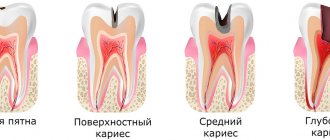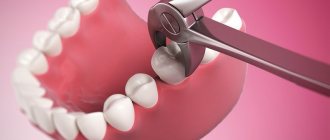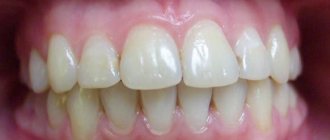Surgical and therapeutic dentistry currently widely use gingival dressings for the purpose of therapeutic and protective effects on the damaged area of the patient’s alveolar process.
A wide variety of dental dressings facilitates the work of dentists and increases the level of patient comfort when it is necessary to apply any type of bandage.
Types of periodontal dressings
Depending on the purpose, a dental bandage can be:
- isolating - applied after surgery, protects the surface of the wound from external factors that aggressively affect the condition of the damaged part of the gum;
- medicinal - containing drugs with different mechanisms of action on foci of inflammation. These can be medications that have an antiseptic, analgesic, antimicrobial, keratoplasty (promoting the restoration of soft tissue) effect.
What types of periodontal dressings are there?
Dressings used in periodontics are classified as follows:
- Medicinal. They are used for rapid transportation of medicinal substances to the gums, periodontal pockets, and interdental spaces, providing a quick therapeutic effect after conservative or surgical periodontal treatment.
- Insulating. They perform a protective function, preventing tissue damage when eating and exposure to oral fluid.
Periodontal dressings are usually divided according to their properties:
- Solid. They perform a protective function and consist of celluloid dissolved in acetone, Boyanov’s stomaticide and other components. They are rarely used, as they irritate the mucous membrane and are fragile.
- Semi-solid dressings are also used infrequently; they have a composition of vulnokol, paraffin, and Atanasova’s zincoplast.
- Soft. They became widespread. Contains zinc oxide and clove oil. They are used to deliver drugs and vitamins to periodontal tissue. Depending on the speed and method of preparation, the dressings have a different spectrum of action and degree of plasticity.
Types of material for therapeutic periodontal dressings
Based on their composition, dental medicinal dressings are divided into several groups:
- Soft are the most common dressings, characterized by speed of production and affordable price. However, it is quite difficult to fix such applications; the duration of their presence in the patient’s oral cavity is quite short. The gel or ointment is applied to a strip of textile material (bandage, gauze), evenly distributed over its entire surface and fixed by throwing the bandage over the surface of the dental crown.
- Semi-solid - used less frequently; there are certain requirements for the use of forms of medicinal preparations: ointments must have a fatty base. The composition of the medicine and paste mixed on a special glass is distributed on a textile basis and transferred to the desired location of the alveolar process. Fixation is achieved by compressing the patient's teeth for 3 to 5 minutes.
- Hard - there are ready-made periodontal dressings and those that are made independently using materials used for taking impressions - repin, dentol. The main feature when working with such material is to use dry and sterile instruments; moisture on the preparation is unacceptable. In the oral cavity, the hard bandage remains plastic for 2 - 3 minutes.
- Adhesive - made on the basis of polyurethane, they are highly hypoallergenic. After polymerization, a plastic film is formed that does not interfere with the oxygen saturation of soft tissues.
- Collagen - widely used after surgery and as therapy for periodontitis. Collagen films are impregnated with various compositions of drugs.
Features of gum dressings - indications for therapeutic applications on periodontium
Gum applications, depending on their composition, can perform several functions simultaneously.
The main criteria for selecting a dressing after surgical procedures are:
- The presence of anesthetics in the composition.
- Degree of wound protection.
- Anti-inflammatory effect.
If treatment is limited to therapeutic measures, the dressing used must have the following properties:
- symmetry is preserved.
- discomfort in the oral cavity.
- The application is fixed for a long period. In such situations, regular medical monitoring is required: the doctor must take care of the rapid restoration of turgor.
Periodontal dressings are used in several cases:
- For the treatment of inflammatory phenomena in periodontal pockets, which can occur as a result of chronic periodontal pathologies, professional teeth cleaning. Upon completion of the manipulations, the doctor injects certain medications into the defective pockets. Without a bandage, such drugs will be ineffective: they will quickly be washed away by saliva.
- After surgical procedures to protect the wound surface. Surgical periodontal plastic surgery at the final stage also involves the application of a gum bandage.
Periodontists do not resort to gum bandages if there is severe inflammation and suppuration in the oral cavity.
Application of therapeutic periodontal dressing
The application of a periodontal dressing is necessarily preceded by surgical or conservative treatment of gums, periodontal pockets, etc., the purpose of such applications is to prolong the effect of medications on periodontal tissue.
Preparation for applying a dressing occurs immediately before the dressing procedure.
It is important to ensure that the bandage is positioned correctly in the oral cavity - it should completely isolate the periodontal pocket from external irritants and not cause discomfort to the patient.
Criteria for the effectiveness of periodontal dressings
Related to drug effects
- Anesthesia
- Reduced exudation activity
- Reducing swelling
- Turgor restoration
- Degree of epithelialization
- Degree of recession
Related to the characteristics of fixation on periodontal tissues
- Fixation duration
- Degree of periodontal wound protection
- Comfort level of periodontal dressing
- Effect on facial symmetry
Requirements for therapeutic periodontal dressings
The combination of comfort and therapeutic effect puts forward some requirements for the quality composition of periodontal dressings:
- their organolepticity - the presence of the material in close proximity to the taste buds implies the acceptability of the ratio of smell, appearance, color;
- compatibility - the material should not react with the components of the medicinal product;
- stability - determined by the ability to maintain the integrity of the bandage for a sufficient amount of time while in the moist environment of the patient’s oral cavity.
The therapeutic periodontal dressing can remain in place from several hours to several days.
Stages of performing gum dressings - timing of wearing applications on the periodontium
The duration of wearing a particular bandage will be determined by its properties, indications, and therapeutic effect:
- For medicinal purposes, applications are applied for 2-3 hours, or for a couple of days. Soft dressings are often used; they do not irritate the oral mucosa and are more comfortable. Medicines are applied to a textile carrier (bandage, gauze), which are distributed with a special spatula. Antibiotics, vitamins, and corticosteroids may be added here. This helps relieve swelling and reduce inflammatory reactions. The optimal wearing period is 3 days.
- Solid and semi-solid dressings are relevant after surgery. They are made from materials that can fix the application for a day. The signal to remove the bandage is the appearance of crumbs in the oral cavity. The duration of their use is 3-7 days.
- Ex tempore dressings are used after professional cleaning of periodontal tissues from contamination. This application can be carried out only after the bleeding has stopped, and its substances should not get into pathological pockets. If bleeding occurs when applying a bandage, everything should be removed. Otherwise, the application will not stick.
- When applied correctly, adhesive compositions Medical glue is applied with a trowel or a tube syringe. After a maximum of 7 minutes (depending on the type of glue), fixation occurs. Before the procedure, the mucous membrane should be dried and degreased.
- The course of treatment with collagen films can reach 20 days, although it is often limited to 7-10 days. Before applying the film to the gum, the film is cut into small rectangles (5x1 cm). One strip should cover no more than 3 teeth: excess material is absorbed fairly quickly.
Rate
—
Types of periodontal dressings
Depending on the properties, the following gum dressings are distinguished:
- hard;
- semi-solid;
- soft;
- adhesive-based compositions;
- collagen films.
The first two types are used relatively rarely due to the fact that they can irritate the inflamed periodontium and are quite fragile. The most common are soft packages consisting of artificial dentin powder, zinc oxide and clove oil, as well as adhesive compositions and collagen-based films. Any medications can be added to such packages, including vitamins, enzymes, and corticosteroid hormones.
Also, according to one of the classifications, all compositions are divided into isolating and therapeutic.
The purpose of insulating bags is to protect the wound surface from saliva and the mechanical impact of chewed food. Therapeutic ones are intended to prolong the effect of drugs on tissues. However, such a division is very conditional.
Classification of periodontal dressings
The classification of periodontal dressings includes therapeutic and isolating dressings. Therapeutic dressings are designed to deposit medications in the localization of problematic periodontal disease, namely in the gums, in periodontal pockets, spaces between teeth during conservative treatment or after surgical intervention, during the treatment of periodontal diseases. Isolating dressings protect periodontal tissues from surrounding irritants.
Depending on the composition and properties, periodontal dressings can be hard, semi-hard or soft. Currently, hard and semi-solid dressings are rarely used, since they mechanically irritate the oral mucosa and are unreliable.
Soft periodontal dressings based on zinc oxide and clove oil have become widespread in practice. Such dressings are flexible, making it easier to administer the necessary medications. The application of such a bandage facilitates the work of the periodontist. The speed of their hardening depends on the composition and method of preparation of the dressing.
Practice shows that applying a therapeutic bandage three times to diseased periodontal tissue provides an excellent therapeutic effect. They are applied for two to three hours, less often for two to three days. Vitamins, herbal remedies, enzymes, antibiotics, corticosteroids, pyrimidine bases, sulfonamide drugs are introduced into the dressings, which have an antimicrobial, anti-inflammatory, and analgesic effect.
Bandages with an isolating effect should be hardening, if possible with a hard-elastic consistency to prevent tissue compression and retention in the oral cavity for about three to seven days after the surgeon's intervention. In practical dentistry, the use of a periodontal bandage is used after cleaning from dental plaque, medicinal treatment and freeing the problem periodontal area from saliva. The necessary pharmacological medicine is placed in the periodontal pockets. The required preparation is mixed in advance on a dental glass and, using a spatula, is applied to the diseased periodontium, to the teeth on the buccal and lingual sides and to the alveolar arch. Next, using a crescent-shaped trowel and cotton balls, the bandage is placed on the cervical part of the tooth crowns and the gingival margin, tightly isolating the entrance to the periodontal canals. The bandage should not get into the periodontal canal, disrupt the occlusion and reach the moving part of the gum. After the surgeon intervenes, the bandage is applied after the bleeding has stopped, otherwise it will not be fixed.
Features of gum dressings
Dentists can use ready-made packages in their work or prepare compositions according to recipes tested in practice. There are a great variety of preparation options, so you can choose the appropriate recipe to solve any problem facing your doctor.
Depending on the goals of treatment, the periodontal package can remain in the oral cavity from several hours to several days. Complete sealing of a periodontal pocket or mucosal wound cleared of contents greatly facilitates the treatment of oral diseases due to:
- isolation of the wound from saliva and other contents of the oral cavity (food, drinks, cigarette smoke, etc.);
- the presence of a mechanical obstacle to the leaching of medications from the wound;
- protection against irritation of damaged mucous membranes and periodontal tissues from chewing.
You can get a significant improvement in the condition of oral tissues after three applications of a package containing medications. Other treatment methods, such as washing periodontal pockets at home or rinsing, will not give such a pronounced effect in such a short time.
Important! In rare cases, individual components of dressings can cause a contact allergic reaction. If you experience itching, pain, rashes or discharge in the area of the bandage, you should immediately contact your dentist.
